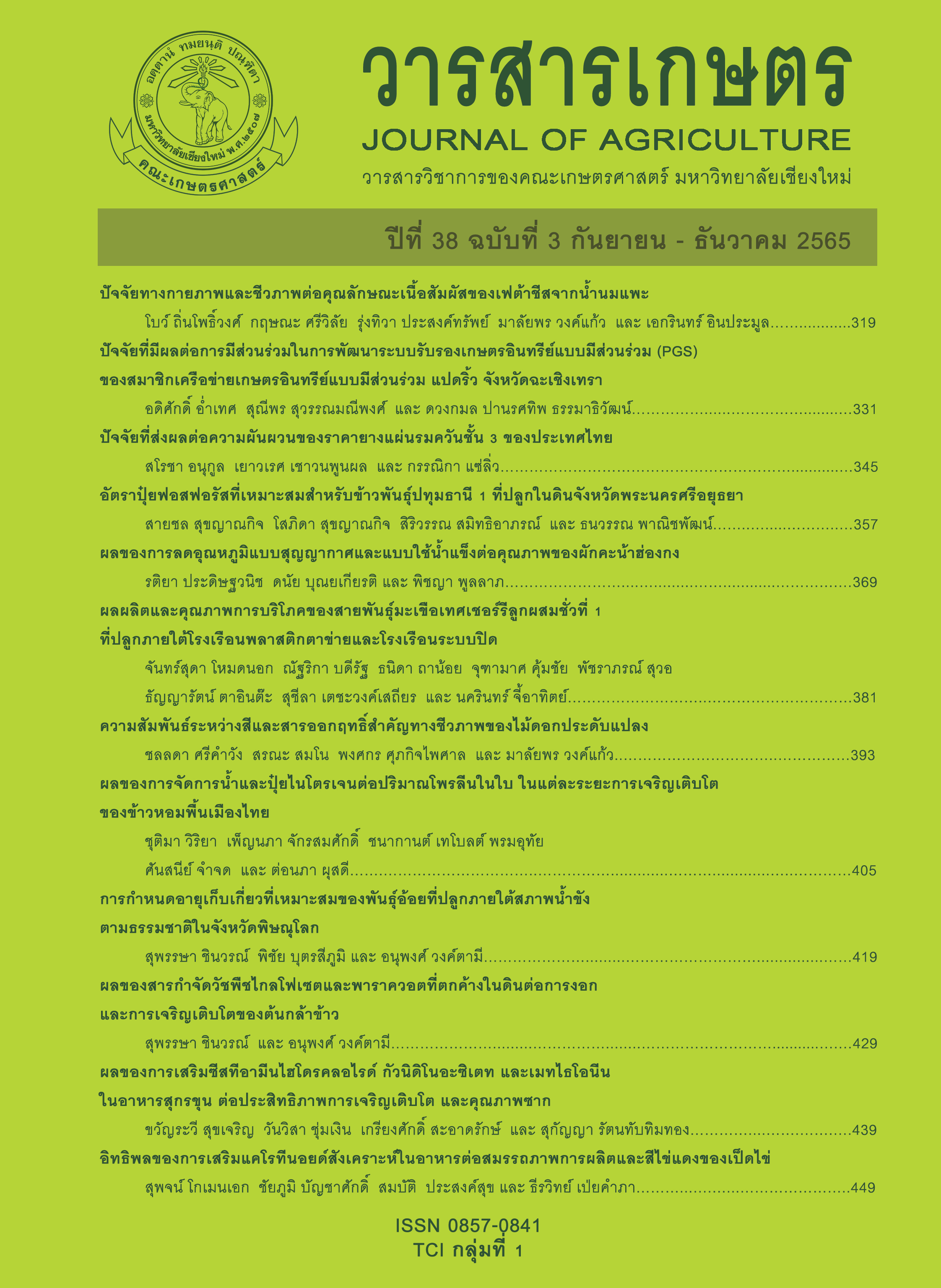Physical and Biological Factors on Textural Characteristics of Feta Cheese from Goat Milk
Main Article Content
Abstract
The Mae Ta Nuea Royal Project Development Center has enhanced the value of goat milk by processing it into Feta cheese, which is one of the functional products. Feta cheese is brined white soft cheeses made from goat and sheep's milk, but other types of milk are currently used, including cow and buffalo milk. This research aimed to determine the commercial bacteria and rennet enzyme contents for Feta cheese production using goat milk to compare quality with commercial Feta cheese. The design of experiment using a 3 x 2 factorial in a completely randomized design was used. In addition, the influence of stirring time on Feta cheese yields was also investigated. The texture profiles of all six treatments with commercial lactic acid bacteria (0.0010, 0.0015 and 0.0020 % w/w) and rennet enzymes (0.0035 and 0.0040 %w/w) were identical to the texture profile of a commercial Feta cheese. All of the treatments produced Feta cheese with a textural profile identical to that of commercial Feta cheese. The Feta cheese treated with the least bacteria (0.001% w/w) and the most rennet (0.001% w/w) had low hardness, great springiness, and adhesiveness, as well as a texture similar to commercial Feta cheese. Furthermore, the yields of Feta cheese obtained from 20, 30 and 40 minutes of stirring time were 13.50, 12.68 and 12.64, respectively. The longer the stirring time, the lower the yield was obtained because of the breakdown of some fats in the curd proteins. This process can be applied as a Feta cheese processing guideline for farmers and entrepreneurs who are interested in value addition goat milk.
Article Details

This work is licensed under a Creative Commons Attribution-NonCommercial-NoDerivatives 4.0 International License.
References
Barbano, D.M. and J.W. Sherbon. 1984. Cheddar cheese yields in New York. Journal of Dairy Science 67(8): 1873-1883.
Bhosale, S.S., P.A. Kahate, K. Kamble, V.M. Thakare and S.G. Gubbawar. 2009. Effect of lactation on physic-chemical properties of local goat milk. Veterinary World 2(1): 17-19.
de Jong, L. 1978. The influence of the moisture content on the consistency and protein breakdown of cheese. Netherlands Milk and Dairy Journal 32(1): 1-14
Everard, C.D., D.J. O’Callaghan, M.J. Mateo, M. Castillo, F.A. Payne and C.P. O’Donnell. 2011. Effects of milk composition, stir-out time, and pressing duration on curd moisture and yield. Journal of Dairy Science (94)6: 2673-2679.
Hammam, A.R.A., R. Kapoor, P. Salunke and L.E. Metzger. 2022. Compositional and functional characteristics of Feta-Type cheese made from micellar casein concentrate. Foods 11(1): 24, doi: 10.3390/foods11010024.
Heller, K.J., W. Bockelmann, J. Schrezenmeir and M. de Vrese. 2003. Cheese and its potential as a probiotic food. pp. 203-225. In: R. Edward (ed). Handbook of Fermented Functional Foods. CRC Press, Boca Raton, Florida.
Hokes, J.C., P.M.T. Hansen and M.E. Mangino. 1989. Functional properties of commercial calcium caseinates for use in imitation cheese. Food Hydrocolloids 3(1): 19-31.
Kandarakis, I., G. Moatsou, A.I.K. Georgala, S. Kaminarides and E. Anifantakis. 2001. Effect of draining temperature on the biochemical characteristics of Feta cheese. Food Chemistry 72(3): 369-378.
Kosikowski, F.V. and V.V. Mistry. 1997. Cheese and Fermented Milk Foods: Origins and Principles. F.V. Kosikowski, Great Falls, Virginia. 729 p.
Kumar, S., S.K. Kanawjia, S. Kumar and S. Khatkar. 2014. Effect of rate of addition of starter culture on textural characteristics of buffalo milk Feta type cheese during ripening. Journal of Food Science and Technology 51(4): 800-804.
Li, J., Q. Huang, X. Zheng, Z. Ge, L. Ke, Z. Dandan, C. Yu, W. Bin and S. Xuewei. 2020. Investigation of the lactic acid bacteria in Kazak cheese and their contributions to cheese fermentation. Frontiers in Microbiology 11: 228, doi: 10.3389/fmicb.2020.00228.
Mauropoulos, A.A. and I.S. Arvanitoyannis. 1999. Implementation of hazard analysis critical control point to Feta and Manouri cheese production lines. Food Control 10(3): 213-219.
Ministry of Agriculture and Cooperatives. 2008. Thai Agricultural Commodity and Food Standard (TACFS 6006 - 2008) B.E. 2551. Ministry of Agriculture and Cooperatives, Bangkok. (in Thai)
Moynihan, A.C., S. Govindasamy-Lucey, J.J. Jaeggi, M.E. Johnson, J.A. Lucey and P.L.H. McSweeney. 2014. Effect of camel chymosin on the texture, functionality, and sensory properties of low-moisture, part-skim Mozzarella cheese. Journal of Dairy Science 97(1): 85-96.
Niludomsak, S. 2001. Effect of ingredients on texture of fishball. M.S Thesis. King Mongkut’s University of Technology Thonburi, Bangkok. 95 p. (in Thai)
Papadopoulou, O.S., A.A. Argyri, E.E. Varzakis, C.C. Tassou and N.G. Chorianopoulos. 2018. Greek functional Feta cheese: Enhancing quality and safety using a Lactobacillus plantarum strain with probiotic potential. Food Microbiology 74: 21-33.
Park, Y.W., M. Juarez, M. Ramos and G.F.W. Haenlein. 2007. Physico-chemical characteristics of goat and sheep milk. Small Ruminant Research 68(1-2): 88-113.
Sommer, B. 2019. The Influence of Lactic Acid Bacteria on the Cheese Texture during Ripening. Food Technology Food Quality and Design. Wageningen University, Wageningen. 29 p.
Steffe, J.F. 1996. Rheological Methods in Food Process Engineering. 2nd ed. Freeman Press, East Lansing, Michigan. 418 p.
Visser, F.M.W. 1977. Contribution of enzymes from rennet, starter bacteria and milk to proteolysis and flavour development in Gouda cheese. Centre for Agricultural Publishing and Documentation Wageningen, Netherlands. 120 p.
Zheng, Y., Z. Liu and B. Mo. 2016. Texture profile analysis of sliced cheese in relation to chemical composition and storage temperature. Journal of Chemistry 2016: 8690380, doi: 10.1155/2016/8690380.


